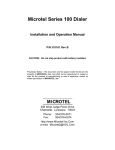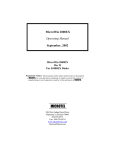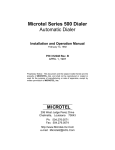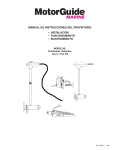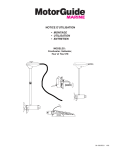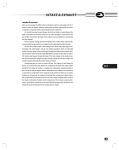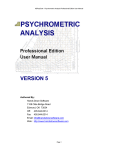Download Microtel 100 Dialer Series Specifications
Transcript
Microtel Series 200 Dialer Installation and Operation Manual P/N 310162 Rev C CAUTION: Do not ship product with battery installed. Proprietary Notice: This document and the subject matter hereto are the property of MICROTEL, Inc. and shall not be reproduced or copied or used for the purpose of manufacturing or sale of apparatus, except by written permission of MICROTEL, Inc. MICROTEL 206 West Judge Perez Drive Chalmette, Louisiana 70043 Phone: Fax: 504/276-0571 504/276-0574 http://www.Microtel-Inc.Com e-mail: [email protected] ii MSC-250 INSTALLATION AND OPERATION MANUAL TABLE OF CONTENTS PAGE I. Introduction A. General Information..................................................................................... 1 B. Unpacking and Incoming Inspection............................................................ 2 C. Physical System Mounting.....................................................................….. 3 D. Battery Installation....................................................................................... 4 E. Power Installation......................................................................……………. 5 F. Telephone Line Installation.......................................................................... 6 G. Fault Monitoring Interface.....................................................…………….…. 7 H. Powering Up the System..............................................................................8 II. Programming the Dialer System A. Fault Mode........................................................................………………….. 9 B. Fault Delay Time...............................................................………………….. 9 C. Fault Messages..........................................................................................10 D. Station Identification Messages........................................................…….. 11 E. Programming Telephone..................................……………………………..12 F. Operational Parameters .................................…………………………….. 12 1. Ring Count.....................……………................................................... 12 2. Tone or Pulse Dial Selection..........................................................…. 13 3. Message Repetitions.......................................................................... 13 4. Intercall Delay..................................................................................... 13 5. Delayed Run……………….................................................................. 14 III. Operations A. System Familiarization and Key Function Summary.................................. 15 B. Putting the Unit in Run....…….................................................................... 16 C. Receiving an Alarm.................................................................................... 17 D. Test and Advanced Keystroke Sequence.................................................. 18 IV. Maintenance and Troubleshooting A. Maintenance…………….............................................................................19 B. System Specifications................................................................................ 20 C. Product Warranty....................................................................................... 21 D. Vocabulary List…...................................................................................... 22 E. Vocabulary List Oil and Gas Industry........................................................ 23 iii iv I. A. INTRODUCTION GENERAL INFORMATION The purpose of this manual is to completely explain the function, installation, and operation of the MCS Model 200 Communication System. This automatic dialing, synthesized speech, telephone based monitoring system represents a new generation of computer controlled telemetry devices, packed with features and capabilities not found in any other telephone oriented monitoring system. The device is designed specifically for industrial based equipment monitoring needs, by the engineering staff which invented the concept of synthesized speech dialers. The System is configured to accept four channels of normally open or normally closed fault state switches (contacts), such as float switches, pressure switches, temperature switches and similar devices that contain an unpowered contact that changes state whenever a preset condition changes. Fault recognition can be set as fast as 1 second or as long as ninety-nine seconds, programmable on a channel-by-channel basis. Internally, the system monitors its own power supply and will respond to any power outage, which persists longer than a user programmable time period. When an alarm occurs, as recognized by the system by the opening or closing of an external contact, it begins to place a series of telephone calls, dialing up to eight different telephone numbers, one at a time, in an attempt to make contact with a qualified person to whom it can deliver a synthesized voice message, describing the alarm condition. This message can be programmed by the user from an internal system vocabulary of sixty five words, to uniquely describe the system location and the alarm condition represented by each channel. The system will continue to call from the list of up to 8 telephone numbers, insisting that its message be heard. Also, if desired, the system can be called at any time to check or verify the monitored conditions. The following instructions generally describe the installation, operation and maintenance of the equipment. Microtel reserves the right to make engineering refinements that may not be described herein.. 1 B. UNPACKING AND INCOMING INSPECTION Microtel takes all possible precautions in packaging each item to prevent shipping damage. Carefully inspect each package at the time of receipt for signs of physical damage. Report damage claims to the shipping agent involved immediately. Do not install damaged equipment. All instructions given on any attached labels or tags should be followed. Carefully inspect all packing material before discarding it to prevent the loss of accessories, mounting hardware, spare parts, or instructions. If the unit is not to be installed immediately, repack it in the shipping carton to protect it while in storage. 2 C. PHYSICAL SYSTEM INSTALLATION Mount the system on a wall or other vertical surface, away from and protected from harsh weather extremes. It is also recommended that the unit not be placed in close proximity to high voltage (480 V and higher) electrical equipment. Four mounting holes on the left and right side enclosure flanges are to be used for system mounting. It is recommended that the system be mounted at eye level to facilitate ease of programming and operation. There are three access holes on the bottom of the unit. The left side port is for the system's telephone line connection. The large hole on the right side of the unit is intended for routing of the system's fault sensing leads, while the smaller hole on the right side of the unit is for the system's power supply transformer. The following figure shows the recommended dimensions to be used in the physical installation of the system. 3 D. BATTERY INSTALLATION The battery is installed at the bottom of the system, in the battery tray provided as part of the interior chassis assembly. IMPORTANT! Before installing the system battery, be certain the power supply transformer is not plugged into an electrical outlet. Remove the four phillips head screws which secure the system's front panel and remove it to expose the system's interior. Note that the panel is still connected to the system's main circuit board, so care must be exercised while the panel is hanging on this "tether". Retrieve the red and black battery leads from within the battery tray. Push the battery lead terminals on to the new battery, BEING CERTAIN that the red lead connects to the positive (+) battery terminal, and the black lead connects to the negative (-) battery terminal. Slide (do not force) the battery completely into the battery tray with the terminals pointed DOWN into the system. If the battery is not completely seated in the battery tray, the front panel will be obstructed and will not fit properly onto its mounting area. A new battery will take no longer than 24 hours to gain a full charge, capable of powering the system through any power outage up to four hours in length. It should be noted that the LOW BATTERY indicator is only valid when the 120 vac power is on. If the LOW BATTERY indicator stays on for more than eight hours, the battery is in need of replacement. 4 E. ELECTRICAL POWER INSTALLATION Electrical power may be applied by simply plugging the system transformer into a nearby electrical outlet. If the system's environment has a history of, or has known electrical power line disturbances, then use of a transient protection module, available as on option from Microtel, is highly recommended. If the unit is to be installed in a location where large or high voltage motors are in use, a power line transient suppressor is also recommended to insure that the unit is not affected by surges and spikes in the 120VAC power to the unit. It is recommended that a separate circuit breaker be used with the system. Remember that when the breaker is on, and the unit is plugged in, 12 vac is contained within the system even though the system Power switch may be turned off. This is to allow continued charging of the system's backup battery, even with the system in a powered down state. The internal system fuse is a 1 amp fuse (Littlefuse #312.001), or equivalent. WHEN INSPECTING OR REPLACING THE FUSE, UNPLUG THE SYSTEM OR THROW THE CIRCUIT BREAKER SUPPLYING POWER TO THE UNIT. 5 F. TELEPHONE LINE INSTALLATION The connection to the telephone network is a matter of simply plugging the modular jack cable into the telephone line termination provided by the telephone utility (RJ-11C or equivalent). This section contains important information regarding the installation of the telephone line to be used by the system, and pertinent information for notifying the telephone company of what type of line is to be installed. The MCS is registered for direct connection to the telephone network by the FCC, which places three restrictions on its use: 1. The system cannot connect to a party line or a pay telephone line. 2. The telephone company must be notified that an FCC registered device is being installed. 3. If trouble is experienced with the device, it must be immediately disconnected form the telephone network. Microtel must make any repairs which may be necessary in order to maintain the FCC registration status of the device. THE FOLLOWING INFORMATION WILL BE REQUIRED BY THE TELEPHONE UTILITY WHICH INSTALLS THE TELEPHONE LINE FOR THE SYSTEM: 1. The FCC Registration Number, which is, D4J6M6-13598-AL-E. 2. The Ringer Equivalence, which is 0.2B. 3. The system needs to be connected to an RJ-11C telephone jack. 6 G. FAULT MONITORING INTERFACE CONNECTIONS The MCS system is designed to accept up to four channels of dry (unpowered), normally open or normally closed signal lines. The system provides a small, pulsed sampling current to determine if the contact is open or closed. Leads from normally open or normally closed switches may be routed through the conduit port at the lower right side of the system. Connect each wire pair to its appropriate channel input terminal pair on the Fault Input Terminal Strip. Shielded, twisted pair, #20 or #22 wire (Belden 8205 or equivalent) is recommended. If shielded cable is used, ground the shield at the sensor and leave the shield floating (unconnected) at the MCS system. Each channel may be configured to be either normally open or normally closed. A channel should be normally open if the "no fault" (Green) condition is that condition which consists of an open circuit on that channel's wire pair. A channel is normally closed if the "no fault" (Green) condition is that condition which consists of a closed circuit on that channel's wire pair. The programming section of this manual will provide details on how to program the Mode (normally open or normally closed) of each channel as well as setting the Fault Delay time for each channel. Any unused channel should be left unconnected and programmed to a normally open mode. . 7 H. POWERING UP THE SYSTEM NOTE: IF THE UNIT ABOUT TO BE POWERED UP FOR THE FIRST TIME CONTAINS HARDWARE FOR OPTIONAL FEATURES, READ THE SUPPLEMENTARY INSTRUCTION MANUAL FOR THOSE FEATURES BEFORE POWERING THE UNIT UP FOR THE FIRST TIME. After the system has been mounted in a suitable area, the battery installed and power, telephone and fault sensing lines connected, it may be powered up by switching the POWER switch to the ON position. This switch is on the system’s front panel. When the unit is powered up, the front panel indicators will flash in sequence for a few moments and the system will say “system ready”. If this does not happen, turn the switch to the OFF position, disconnect the power and the telephone line from the unit. Contact a qualified service person or Microtel, Inc. for instructions. 8 II. PROGRAMMING THE DIALER SYSTEM For this section, be advised that the keystroke entries are CAPITALIZED and the system's responses whether visual or audible, are enclosed within [brackets]. The system must be in the Halt mode to accept programming information. If it is not in the Halt mode, depress the HALT key to force that condition. ["system ready"] A. FAULT MODE PROGRAMMING The fault status of each of the five channels is shown as a fault (RED) or no-fault (GREEN) condition on the corresponding front panel indicator. The system allows the user to specify whether an open contact condition should be regarded as a GREEN (no fault), or as a RED (fault) state. To program each channel, first apply a no fault contact state to each input. This means shorting the input if a normally closed contact mode is to be used, or opening the input connections if a normally open contact mode is to be used. For each channel, a Normally Open Mode is equal to a "1", and, a Normally Closed Mode is equal to a "0". For each fault input channel, perform the following programming steps: 1. ENTER, MODE, N(1,2,3, or 4) [fault N mode ready] 2. 1 (for normally open mode) or 0 (for normally closed mode) [fault N mode is (1 or 0)] To verify the proper mode, simulate the opening or closing of the fault input contacts and view the proper state indication (RED or GREEN) on the system front panel. To read the Fault Mode for each channel, the following steps should be performed: 1. READ, MODE, N(1,2,3, or 4) [fault N mode is (1 or 0)] B. FAULT DELAY TIME PROGRAMMING Each channel may be programmed for its own fault delay time response, from 1 to ninety-nine seconds. This means that the system will either display or respond to a fault channel changing from a no fault to a fault condition for this time period. Changes from a fault to a no fault condition are, however, instantly detected by the system. To program the Delay Time for each fault channel (Channels 1,2,3, and 4) and the Power Fault channel (Channel 5), perform the following programming steps: 9 1. ENTER, DELAY, N(1,2,3,4, OR 5) [fault N (or power fault) delay ready] 1. XY (00 to 99) (seconds of delay) [fault N (or power fault) delay is XY (00 to 99) To verify the proper delay time, simulate the opening or closing of the fault input contacts and view the proper state indication (RED or GREEN) on the system front panel. The fault channel will change from a GREEN to a RED state after the programmed delay. It will change from a RED to a GREEN state almost immediately. To read the Fault Delay for each channel, the following steps should be performed: 1. C. READ, DELAY, N(1,2,3,4, or 5) [fault N (or power fault) delay is XY (00 to 99) FAULT MESSAGES The system allows the user to program sentences up to eight words in length to be spoken by the system identifying each fault condition. The unit is shipped with nonspecific phrases already programmed in. The system will articulate the channels as "fault 1, fault 2,...and power fault". This programming operation may be used for all channels, which are to be used by the system, or the pre-programmed, default phrases may be used for any or all of the messages. The following programming steps should be performed for the creation of fault channel messages: 1. ENTER, MESSAGE, N (1,2,3,4, or 5) [message N ready] 2. Enter the desired two digit word addresses from the system vocabulary lists found in the appendix (each word selected will be spoken by the system following its two digit entry). 3. Terminate entry sequence with a second depression of ENTER [message N is ... (word1),(word2), (word3)...(word 8)] To read or verify the message for each channel, 1. READ, MESSAGE, N(1,2,3,4, or 5) [message N is...(word1),(word2),(word3)...(word 8] Status Only Channel Programming Any fault channel may be programmed as a "status only" channel (i.e. it will not cause call-outs to begin, but will be reported in any status messages). To program a channel as a "status only" channel, program the word "tone" from the vocabulary list as the first word in the fault message for that channel. The unit will make a "beep" sound after the 2-digit code for "tone" is entered. The remaining seven words identifying that channel may then be entered as indicated above. 10 D. STATION IDENTIFICATION There are two ways to enter a station identification message into the system. The station can be identified as a number up to eight digits in length, in which case the system will refer to itself as, "this is station XX...X". Alternatively, the system will allow the entry of up to sixteen words from system vocabulary, to be connected together into one identification message. For instance, the station identification "This is the east plant" is comprised of five words from the system's vocabulary. The first case is called the Number Mode, while the later is referred to as the Message Mode of station identification entry. NUMBER MODE ENTRY OF STATION IDENTIFICATION MESSAGE 1. ENTER, 0 [station number, ready] 2. Enter desired digits, terminate the entire entry with a second depression of ENTER [the station number is xx...x] To read the station number for verification, 1. READ, 0 [the station number is xx...x] MESSAGE MODE ENTRY OF STATION IDENTIFICATION MESSAGE 1. ENTER, MESSAGE,O [station identification, ready] 2. Enter desired words by entering the appropriate two digit code for each word in sequence from the vocabulary list found in the appendix. Terminate the entry sequence with a second depression of ENTER. [the station identification is ... (words), (word2), (word3)...(word 16)"] To read the station identification message for verification, 1. READ, MESSAGE,O [the station identification is ...(word1),(word2), (word3)...(word 16)"] 11 E. PROGRAMMING TELEPHONE NUMBERS The system can be programmed with up to eight telephone numbers, which will be called sequentially when an abnormal condition is detected by the system on any fault channel not programmed as a "status only" channel. The following programming procedure should be performed to enter telephone numbers into the system. Note that there must be at least one telephone number programmed into the system for it to operate at all. All eight telephone number data locations need not be programmed. Telephone numbers may be deleted by entering a "0" into the data location for that number in the list. 1. ENTER,N (1,2,...8) [telephone number N, ready] 2. Enter the desired phone number by depressing the numbers on the keypad. The unit will repeat each number as you depress it. 3. Terminate the entry with a second depression of ENTER [telephone number N is nnn...n] To read this data for verification, 1. READ, N (1,2,...8) [telephone number N is...nnn...n] Up to 16 digits may be entered for each phone number position. If any of the numbers the unit is to call require a pause for a second dial tone, enter the pause by using the DELAY key in place of a digit. To clear a phone number out of the unit, enter a 0 (zero) as the phone number. The unit ignores any phone number that starts with a 0. If you wish to have the unit call the operator, enter the phone number as DELAY, 0 F. OPERATIONAL PARAMETERS This section describes the procedure for setting 4 operational parameters. All of these parameters are entered into the system using the system's programming keypad. 1. Setting the Ring Count The ring count is the number of rings the unit will wait before answering a call placed to it. This may be set to any number of incoming rings from 1 to 99. 1. 2. ENTER, [ring count, ready] enter a two digit number from 01 to 99 representing the desired ring count [the ring count is XY] To check the ring count programmed into the system, 1. READ, 12 [the ring count is XY] 2. Tone or Pulse Dial Selection The system needs to be set for pulse or tone type dialing. Perform this selection by following these programming steps. Before programming the unit to function in a tone dialing mode, confirm with the telephone company that services the installation that the line to which the unit is connected to will accept tone dialing. 1. ENTER, MODE, 0 [telephone mode, ready] 2. enter "0" for pulse type dialing, or “1” for tone type dialing [telephone mode is X] To verify the dialing mode, 1. 3. READ,MODE, 0 [telephone mode is X] Message Repetitions The system will repeat its fault status message a number of times in the course of any telephone call which it places. The system is shipped programmed to repeat the message 8 times during each call. If it is necessary to change this number, perform the following programming steps. 1. 2. ENTER, # [message count, ready] Enter a two digit number corresponding to the desired number of message repetitions (01 to 99) [the message count is xx] To read and verify this data, 1. 4. READ, # [the message count is xx] Intercall Delay When a call place by the system is acknowledged (see section III.C. for the acknowledgement procedure) it will delay further calls for a programmable period to allow time for the condition to be corrected. This time delay period following an acknowledged call is called the intercall delay. The unit is shipped with this delay set to 1 hour. It may be from one to 99 hours and is programmed at the system keyboard as follows. 13 1. ENTER, DELAY, 0 [intercall delay, ready] 2. Enter a two digit number corresponding to the desired number of hours of delay [the intercall delay is xx hours] (Numbers less than 10 must be entered with a 0, as in 01, 05, etc.) To read this data, 1. READ, DELAY, 0 [the intercall delay is xx hours] 5. Delay Run Programming The Run Mode may be entered after a programmable delay. To do so, 1. Depress DELAY, RUN [system delay, ready] 2. Enter the desired two digit delay in minutes (01 to 99 minutes) [the system delay is xx minutes] (Values less than 10 minutes must be entered with a preceding 0, i.e. 01, 07...) The flashing Run indicator verifies that the system is in the delayed run mode. After the delay is completed, the system will enter the Run Mode and the Run indicator will stay on. 14 III. A. OPERATIONS SYSTEM FAMILIARIZATION AND KEY FUNCTION SUMMARY The power switch for the system is located on the Front Panel of the system. It is important to note that when 12 vac power is connected to the system, this switch does not remove 12 vac power from the unit--it is always present unless the circuit breaker, which the INSTALLER must supply, is turned off, or the transformer is removed from the power outlet. There are six indicators across the topside of the keyboard assembly on the front panel. These LEDs will indicate the state of the fault channels which the system is intended to monitor, indicating RED for a fault condition and GREEN for a no-fault condition, along with a system status indicator which display RED for the HALT mode and GREEN for the RUN mode. On the left side of the system front panel, is the system speaker. This speaker allows words the system synthesizes to be heard, as well as telephone line sounds when the system is on the telephone line placing an alarm call. A description of each of the system's keys and their functions now follows: HALT The HALT key will abort any operation in process, and return the system to the Halt mode as indicated by the RUN STATUS indicator. In this mode, fault conditions will not be acted upon by the system. However, it is still possible to call the system. The system will answer the call and deliver the appropriate fault status message. RUN The RUN key will place the system in a run mode as indicated by the RUN STATUS indicator. If fault conditions exist, the system will begin placing telephone calls (if telephone numbers have been programmed into the system). Use of the Delay key in conjunction with the RUN key will cause the system to execute a delayed entry into the Run mode--which may be programmed to be up to 99 minutes (see the section entitled "Putting the System in Run" later in this section for more information on this feature). MODE The MODE key is used in conjunction with other keys to effect certain features in system programming including fault modes and tone/dial selection. SEQUENCE The SEQUENCE key is a preface key, which allows some of the advanced operation features of the system to be activated. Until the purpose and use of this key is explained later in this manual, it is advisable to leave it alone. If this key is randomly operated with others, a proper keystroke combination could occur, wiping out portions of telephone number and other data. ENTER The ENTER key is used to enter data which the system must use in performing its monitoring and alarming functions. Included in this data are telephone numbers, fault messages, the system identification message, the message count, and the intercall delay. 15 MESSAGE The MESSAGE key is used in conjunction with others to program the message for each fault channel, and the system identification message. Additionally, depression of the message key alone when the system is in the Halt mode will cause the current ID and status messages to be articulated by the system. READ The READ key is used to recall any of the programmed information. DELAY The DELAY key has four functions: When used in telephone number programming, it inserts a short pause between digits in a telephone number. When used with the ENTER key,(i.e. ENTER, DELAY,O) it sets the intercall delay time; that is, the time the system will wait after its callout message has been acknowledged before it begins placing regular calls again (see section II of this manual for additional information). When the DELAY key is used with the RUN key, (DELAY, RUN) it allows delayed, automatic entry into the Run mode. When the DELAY key is used for fault delay time programming, it allows the entry of integration or delay times for the detection of each fault condition. DIGITS 1 THROUGH 0 The digits keys are used for numeric entry of data values and data locations. * KEY The * key is used as an entry location for ring count programming. The ring count is the number of incoming telephone rings which the system will count before answering and servicing the incoming call. (see Section II of this manual for more information) Additionally, the * key is the key used over the telephone for acknowledgement of the system callout message. It is also useable locally (on the system keyboard) for acknowledgement right at the system. # KEY The # key is used as an entry location for the message count. This is the number of times that the entire fault status message is repeated in the course of each telephone call placed by the system. (see Section II of this manual for more information) B. PUTTING THE SYSTEM IN RUN After all operational data has been entered into the system, the unit is ready to enter the run mode, from which any fault channels will be acted upon--causing calls to be placed to the programmed telephone numbers. 16 To place the system is the Run Mode, depress the RUN key on the system front panel. The Run indicator will verify successful entry into the Run Mode. Delayed Entry into the Run Mode The Run Mode may be entered after a programmable delay. To do so, 1. depress DELAY, RUN [system delay, ready] 2. enter the desired two digit delay in minutes (01 to 99 minutes) [the system delay is xx minutes] (values less than 10 minutes must be entered with a preceding 0, i.e. 01, 07...) The flashing Run indicator verifies that the system is in the delayed runmode. After the delay is completed, the system will enter the Run Mode and the Run indicator will stay on. C. RECEIVING AN ALARM When a valid alarm condition is recognized by the system, it will be indicated locally on the system front panel. If the system is in the Run Mode, it will immediately begin placing telephone calls to the telephone numbers, which have been programmed by the user. Upon the receipt of an alarm call, the answering party will hear the station identification, followed by the current status messages. This entire message will be repeated the number of times programmed. If the entire message sequence is completed without an acknowledgement being returned over the telephone link, the system will terminate the call, wait 70 seconds for a call back acknowledgement, and then place a call to the next telephone number in the list. If an acknowledgement is not received from the next call, after the 70 second wait, a 3rd call will be placed, and so on. The unit will continue to call repeatedly from the user's programmed list of telephone numbers indefinitely, until it receives an acknowledgement or the fault condition is removed. If the system is acknowledged during the call, it will not place any further calls for a time programmed as the Intercall Delay. If a new fault condition occurs during that period, the delay will abort and calls will begin again. If the entire delay expires and the fault conditions still persist, the system will again begin to place telephone calls. To Acknowledge a Call From the System Acknowledgement may be accomplished by depressing the * key on the called telephone between message repeats during the alarm call. The * key must be depressed for at least 1 second but no longer than five seconds. The system will verify that the acknowledgement has been accepted by saying, [acknowledgement accepted, the intercall delay is xx hours"]. If acknowledgement must be returned from a telephone without tone capability, the system may be acknowledged by placing an immediate call back to the system, 17 within 60 seconds after it has completed its call. Again, the system will verify that the acknowledgement has been accepted by saying, [acknowledgement accepted, the intercall delay is xx hours]. D. TEST AND ADVANCED KEYSTROKE SEQUENCES A number of sequence commands are possible on the system front panel keyboard. These are as follows: ARCHIVE DATA RECOVERY SEQUENCE 40 [the number of calls placed by the system] SEQUENCE 41 [the number of acknowledgements returned] SEQUENCE 42 [the number of calls placed by the system] SEQUENCE 43 the number of power faults] SEQUENCE 44 [the number of resets or HALT key entries] SYSTEM LEVEL TEST SEQUENCES SEQUENCE 50 [vocabulary dump] SEQUENCE 52 flash test all front panel indicators (HALT to terminate this sequence) SEQUENCE 53 calculate internal memory checksum value SEQUENCE 55 Acknowledge tone adjustment self test PRESET ALL DATA VALUES TO DEFAULT NOTE: Do not use these sequences unless you are thoroughly aware of the results, which will occur--that is, the resetting of operational data to default values, and destroying any numbers, messages, or delays, which may have been entered by the user. SEQUENCE 60 preset all messages to default (Fault 1, Fault 2, etc.) SEQUENCE 61 preset telephone numbers only (all become 0) SEQUENCE 62 reset all archive data to 0 values 18 IV MAINTENANCE AND TROUBLESHOOTING In the unlikely event that trouble is suspected with the system, it must be promptly disconnected from the telephone network, and referred to Microtel or its authorized service representatives. A service manual detailing troubleshooting procedures is available to qualified personnel. Periodically inspect the system internally for any evidence of moisture, blown fuses, or battery failure as instructed herein. A. MAINTENANCE 1. Battery Care Battery life is dependant upon a number of factors, and will vary depending on the number of outages, and the age of the battery. A new battery will take no longer than 24 hours to gain a full charge, capable of powering the system through any power outage up to four hours in length. It should be noted that the LOW BATTERY indicator is only valid when the 120 vac power is on. If the LOW BATTERY indicator stays on for more than eight hours, the battery is in need of replacement. 2. Battery Replacement The battery is installed at the top of the system, in the battery tray provided as part of the interior chassis assembly. It is necessary to remove power from the system by throwing the supply circuit breaker or removing the power transformer from the power outlet before replacing the battery. Refer to Section I.C - Battery Installation for instructions on installing a new battery. 3. Volume Adjustment The volume of the system's speech messages delivered to the telephone network is fixed. The volume of the speech heard through the system speaker is, however, adjustable by varying the setting of potentiometer R21, located on the main circuit card in the unit. 4. Acknowledge Tone Adjustment R33, located on the system's main board, is the adjustment for the frequency detected during the acknowledgement of an alarm call. By activating SEQUENCE 55 (see previous section) the system will deliver a continuous acknowledge tone (* key) to itself, during which the potentiometer R33 may be set. Center the adjustment by varying the setting until the Acknowledge LED on the front panel turns on. There is some amount of hysteresis associated with this detection so the centering of the component must take into account approaches from each direction. The continuous tone used for adjustment may be halted by depressing the HALT key after the adjustment is completed. 19 B. System Specifications ENVIRONMENTAL Temperature Humidity Surge -10F to +12OF 90% RH, Non-condensing 2500 V, Per ANSI C37-90A-1974, common and differential mode per FCC part 15C EMI/RFI ELECTRICAL Power requirements Fault sensing current Battery Backup Power outage detection time 120 VAC, 50/60 Hz, 7 watts Less then 10 mA per channel 4 hours typical 1-99 seconds PHYSICAL Dimensions Weight Mounting method Enclosure 11 5/8 x 9 7/16 x 4 inches 10 lbs. Flange mount, 4 points NEMA 12 std., others optional TELEPHONE SYSTEM FCC registered for direct interconnect FCC Registration Number: D4J6M6-13598-AL-E Dialing capacity 8 numbers, 16 digits each, maximum Loop disconnect, 10 pps nominal; or tone, 100ms/100ms; user selectable Programmable, 1 to 99 rings Programmable, 1 to 99 hours One Minute Per FCC part 68 Dialing format Answer delay Acknowledged intercall delay Unacknowledged intercall delay Surge and environmental protection OPERATIONAL Fault detection method Normally open or closed, selectable One to 99 seconds Name or number, user selectable user programmable messages One to 99, user programmable Nonvolatile EEPROM Local keyboard entry Fault integration time constant Station identification Message repetitions Data retention Programming 20 SYSTEM DIAGNOSTICS Audible indicators Line monitor Vocal status of all data, fault conditions and parameters Fault channels Run status Off hook Incoming call Power on Battery condition Intercall delay in progress Successful acknowledgment Visual indicators C. PRODUCT WARRANTY We warrant to the original purchaser the Microtel unit manufactured by us to be free from defects in material and workmanship under normal use and service. Our obligation under this warranty shall be limited to the repair or exchange of any part or parts which may thus prove defective under normal use and service within one year from date of installation by the original purchaser, in no event shall this warranty apply to equipment after the expiration of eighteen (18) months from date of shipping to the original purchaser whether or not the equipment is installed and which our examination shall disclose to our satisfaction to be defective. THIS WARRANTY IS EXPRESSLY IN LIEU OF ALL OTHER WARRANTIES EXPRESSED OR IMPLIED INLCUDING THE WARRANTIES OF MERCHANTABILITY AND FITNESS FOR USE AND OF ALL OTHER OBLIGATIONS OR LIABILITIES ON OUR PART, AND WE NEITHER ASSUME, NOR AUTHORIZE ANY OTHER PERSON TO ASSUME FOR US, ANY OTHER LIABILITY IN CONNECTION WITH THE SALE OF THIS MICROTEL UNIT OR ANY PART THEREOF WHICH HAS BEEN SUBJECT TO ACCIDENT, NEGLIGENCE, ALTERATION, ABUSE, OR MISUSE. WE MAKE NO WARRANTY WHATSOEVER IN RESPECT TO ACCESSORIES OR PARTS NOT SUPPLIED BY US. THE TERM "ORIGINAL PURCHASER", AS USED IN THIS WARRANTY, SHALL BE DEEMED TO MEAN THAT PERSON FOR WHOM THE MICROTEL UNIT IS ORIGINALLY INSTALLED. 21 D. MCS 200 VOCABULARY WORD ADDRESS WORD ADDRESS ZERO ONE TWO THREE FOUR FIVE SIX SEVEN EIGHT NINE ACCEPTED ACKNOWLEDGE ALARM AMMONIA CHLORINE COUNT DELAY DIOXIDE DISCHARGE EAST EMERGENCY FAILURE FAULT FIRE FLOODING FLOW GAS HIGH HOURS IDENTIFICATION INTERCALL INTRUSION IS 00 01 02 03 04 05 06 07 08 09 10 11 12 13 14 15 16 17 18 19 20 21 22 23 24 25 26 27 28 29 30 31 32 LEAK LEVEL LIFT LOW MESSAGE MODE NORMAL NORTH NUMBER OFF ON PLANT POWER PRESSURE PUMP READY RESIDUAL RING SOUTH STATION STATUS SULFER SYSTEM TELEPHONE THE THIS TONE (beep) VACUUM WAIT (pause) WATER WELL WEST 33 34 35 36 37 38 39 40 41 42 43 44 45 46 47 48 49 50 51 52 53 54 55 56 57 58 59 60 61 62 63 64 22 E. MCS 200 VOCABULARY OIL AND GAS INDUSTRY WORD ADDRESS WORD ADDRESS ZERO ONE TWO THREE FOUR FIVE SIX SEVEN EIGHT NINE ACCEPTED ACKNOWLEDGE ALARM CALL CLOSED COMPRESSOR CONTACTOR COUNT DELAY DIFFERENTIAL DISCHARGE DOWN EAST EMERGENCY ENTRY FAILURE FAULT FILTER FIRE FLARE FLOODING FLOW GAS HEADER HIGH HOURS H2S IDENTIFICATION INTERCALL INTRUSION IS 00 01 02 03 04 05 06 07 08 09 10 11 12 13 14 15 16 17 18 19 20 21 22 23 24 25 26 27 28 29 30 31 32 33 34 35 36 37 38 39 40 LEAK LEASE LEVEL LOW MESSAGE MODE NORMAL NORTH NUMBER OFF OIL ON OPEN PLANT POWER PRESSURE PUMP READY RING SCRUBBER SET POINT SHUTDOWN SOUTH STATION STATUS SUCTION SYSTEM TANK TELEPHONE TEMPERATURE THE THIS TONE (beep) UNAUTHORIZED VACUUM VALVE WAIT (pause) WATER WELL WEST 41 42 43 44 45 46 47 48 49 50 51 52 53 54 55 56 57 58 59 60 61 62 63 64 65 66 67 68 69 70 71 72 73 74 75 76 77 78 79 80 23



























